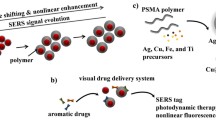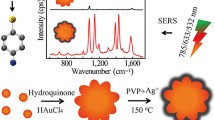Abstract
A sol–gel method has been developed to fabricate Au/SiO2/quantum dot (QD) core–shell–shell nanostructures with plasmonic-enhanced photoluminescence (PL). Au nanoparticle (NP) was homogeneously coated with a SiO2 shell with adjusted thickness through a Stöber synthesis. When the toluene solution of hydrophobic CdSe/ZnS QDs was mixed with partially hydrolyzed 3-aminopropyltrimethoxysilane (APS) sol, the ligands on the QDs were replaced by a thin functional SiO2 layer because the amino group in partially hydrolyzed APS has strong binding interaction with the QDs. Partially hydrolyzed APS plays an important role as a thin functional layer for the transfers of QDs to water phase and the subsequent connection to aqueous SiO2-coated Au NPs. Although Au NPs were demonstrated as efficient PL quenchers when the SiO2 shell on the Au NPs is thin (less than 5 nm), we found that precise control of the spacing between the Au NP core and the QD shell resulted in QDs with an enhancement of 30 % of PL efficiency. The Au/SiO2/QD core/shell/shell nanostructures also reveal strong surface plasmon scattering, which makes the Au/SiO/QD core–shell–shell nanostructures an excellent dual-modality imaging probe. This technology can serve as a general route for encapsulating a variety of discrete nanomaterials because monodispersed nanostructures often have a similar surface chemistry.








Similar content being viewed by others
References
Barnes WL (1998) Fluorescence near interfaces: the role of photonic mode density. J Mod Opt 45:661–699. doi:10.1080/09500349808230614
Bruchez MP, Moronne M, Gin P, Weiss S, Alivisatos AP (1998) Semiconductor nanocrystals as fluorescent biological labels. Science 281:2013–2016. doi:10.1126/science.281.5385.2013
Chan YH, Chen J, Wark SE, Skiles SL, Son DH, Batteas JD (2009) Using patterned arrays of metal nanoparticles to probe plasmon enhanced luminescence of CdSe quantum dots. ACS Nano 3:1735–1744. doi:10.1021/nn900317n
Gerion D, Pinaud F, Shara Williams SC, Parak WJ, Zanchet D, Weiss S, Paul Alivisatos A (2001) Synthesis and properties of biocompatible water-soluble silica-coated CdSe/ZnS semiconductor quantum dots. J Phys Chem B 105:8861–8871. doi:10.1021/jp0105488
Gersten J, Nitzan A (1981) Spectroscopic properties of molecules interacting with small dielectric particles. J Chem Phys 75:1139–1152. doi:10.1063/1.442161
Gisin N, Ribordy G, Tittel W, Zbinden H (2002) Quantum cryptography. Rev Mod Phys 74:145–195. doi:10.1103/RevModPhys.74.145
Grabolle M, Spieles M, Lesnyak V, Gaponik N, Eychmüller A, Resch–Genger U (2009) Determination of the fluorescence quantum yield of quantum dots: suitable procedures and achievable uncertainties. Anal Chem 81:6285–6294. doi:10.1021/ac900308v
Gryczynski I, Malicka J, Jiang W, Fischer H, Chan WCW, Gryczynski Z, Grudzinski W, Lakowicz JR (2005) Surface-plasmon-coupled emission of quantum dots. J Phys Chem B 109:1088–1093. doi:10.1021/jp046173i
Hillman EMC, Moore A (2007) All-optical anatomical co-registration for molecular imaging of small animals using dynamic contrast. Nat Photonics 1:526–530. doi:10.1038/nphoton.2007.146
Jones M, Nedeljkovic J, Ellingson RJ, Nozik AJ, Rumbles GJ (2003) Photoenhancement of luminescence in colloidal CdSe quantum dot solutions. Phys Chem B 107:11346–11352. doi:10.1021/jp035598m
Kulakovich O, Strekal N, Yaroshevich A, Maskevich S, Gaponenko S, Nabiev I, Woggon U, Artemyev M (2002) Enhanced luminescence of CdSe quantum dots on gold colloids. Nano Lett 2:1449–1452. doi:10.1021/nl025819k
Lackowicz JR (2001) Radiative decay engineering: biophysical and biomedical applications. Anal Biochem 298:1–24. doi:10.1006/abio.2001.5377
Lackowicz JR (2004) Radiative decay engineering 3. Surface plasmon-coupled directional emission. Anal Biochem 324:153–169. doi:10.1016/j.ab.2003.09.039
Liu N, Prall BS, Klimov VI (2006) Hybrid gold/silica/nanocrystal-quantum-dot superstructures: synthesis and analysis of semiconductor-metal interactions. J Am Chem Soc 128:15362–15363. doi:10.1021/ja0660296
Liz-Marzán LM, Giersig M, Mulvaney P (1996) Synthesis of nanosized gold-silica core–shell particles. Langmuir 12:4329–4335
Murase N (2010) Quantum dot–core silica glass–shell nanomaterials: synthesis, characterization, and potential biomedical applications, vol 6. In Kumar C (ed) Nanomaterials for the life sciences. Wiley, New York, p. 393. doi:10.1002/9783527610419.ntls0201
Murase N, Li C (2008) Consistent determination of photoluminescence quantum efficiency for phosphors in the form of solution, plate, thin film, and powder. J Lumin 128:1896–1903. doi:10.1016/j.jlumin.2008.05.016
Nann T, Mulvaney P (2004) Single quantum dots in spherical silica particles. Angew Chem Int Ed 43:5393–5396. doi:10.1002/anie.200460752
Noginov MA, Zhu G, Belgrave AM, Bakker R, Shalaev VM, Narimanov EE, Stout S, Herz E, Suteewong T, Wiesner U (2009) Atmospheric carbon dioxide through the eocene–oligocene climate transition. Nature 460:1110–1114. doi:10.1038/nature08447
Okamoto K, Vyawahare S, Scherer A (2006) Surface-plasmon enhanced bright emission from CdSe quantum-dot nanocrystals. J Opt Soc Am B 23:1674–1678. doi:0740-3224/06/081674-5/
Ozel T, Nizamoglu S, Sefunc MA, Samarskaya O, Ozel IO, Mutlugun E, Lesnyak V, Gaponik N, Eychmuller A, Gaponenko SV, Demir HV (2011) Anisotropic emission from multilayered plasmon resonator nanocomposites of isotropic semiconductor quantum dots. ACS Nano 5:1328–1334. doi:10.1021/nn1030324
Pompa PP, Martiradonna L, Torre AD, Sala FD, Manna L, Vittorio MD, Calabi F, Cingolani R, Rinaldi R (2006) Metal-enhanced fluorescence of colloidal nanocrystals with nanoscale control. Nat Nanotechnol 1:126–130. doi:10.1038/nnano.2006.93
Rogach AL, Nagesha D, Ostrander JW, Giersig M, Kotov NA (2000) “Raisin bun”-type composite spheres of silica and semiconductor nanocrystals. Chem Mater 12:2676–2685. doi:10.1021/cm000244i
Salgueiriño-Maceira V, Correa-Duarte MA, Spasova M, Liz-Marzán LM, Farle M (2006) Composite silica spheres with magnetic and luminescent functionalities. Adv Funct Mater 16:509–514. doi:10.1002/adfm.200500565
Selvan ST, Tan TT, Ying JY (2005) Robust, non-cytotoxic, silica-coated CdSe quantum dots with efficient photoluminescence. Adv Mater 17:1620–1625. doi:10.1002/adma.200401960
Song JH, Atay T, Shi S, Urabe H, Nurmikko AV (2005) Large enhancement of fluorescence efficiency from CdSe/ZnS quantum dots induced by resonant coupling to spatially controlled surface plasmons. Nano Lett 5:1557–1561. doi:10.1021/nl050813r
Wang EH, Smolyaninov II, Davis CC (2010) Surface plasmon polariton enhanced fluorescence from quantum dots on nanostructured metal surfaces. Nano Lett 10:813–820. doi:10.1021/nl9031692
Yang P, Murase N (2010) Size-tunable highly luminescent SiO2 particles impregnated with number-adjusted CdTe nanocrystals. ChemPhysChem 11:815–821. doi:10.1002/cphc.200900850
Yang P, Murase N, Suzuki M, Hosokawa C, Kawasaki K, Kato T, Taguchi T (2010) Bright, non-blinking, and less-cytotoxic SiO2 beads with multiple CdSe/ZnS nanocrystals. Chem Commun 46:4595–4597. doi:10.1039/C002243H
Yang P, Ando M, Murase N (2011) Various Au nanoparticle organizations fabricated through SiO2 monomer induced self-assembly. Langmuir 27:895–901. doi:10.1021/la103143j
Yi DK, Lee SS, Ying JY (2006) Synthesis and applications of magnetic nanocomposite catalysts. Chem Mater 18:2459–2461. doi:10.1021/cm052885p
Yuan CT, Yu P, Ko HC, Huang J, Tang J (2009) Antibunching single-photon emission and blinking suppression of CdSe/ZnS quantum dots. ACS Nano 3:3051–3056. doi:10.1021/nn900760u
Author information
Authors and Affiliations
Corresponding author
Electronic supplementary material
Below is the link to the electronic supplementary material.
Rights and permissions
About this article
Cite this article
Yang, P., Kawasaki, K., Ando, M. et al. Au/SiO2/QD core/shell/shell nanostructures with plasmonic-enhanced photoluminescence. J Nanopart Res 14, 1025 (2012). https://doi.org/10.1007/s11051-012-1025-z
Received:
Accepted:
Published:
DOI: https://doi.org/10.1007/s11051-012-1025-z




